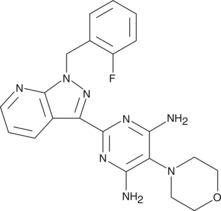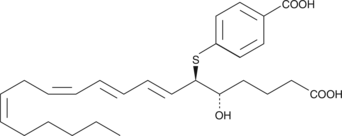Chemicals
Showing 10951–11100 of 41137 results
-
The transcription factor NF-κB plays a key role in regulating over 150 target genes including the expression of inflammatory cytokines, chemokines, immunoreceptors, and cell adhesion molecules.{13643} In the cytoplasm, inactive NF-κB complexes are bound to an inhibitor IκB.{12959} However in response to certain stimuli, IκB is phosphorylated, ubiquitinated, and degraded, enabling the translocation of NF-κB to the nucleus.{13642} BAY 11-7082 selectively and irreversibly inhibits NF-κB activation by blocking TNF-α-induced phosphorylation of IκB-α without affecting constitutive IκB-α phosphorylation.{16037} This compound inhibits the TNF-α-induced surface expression of adhesion molecules ICAM-1, VCAM-1, and E-selectin in human endothelial cells with IC50 values of 5-10 µM.{16037}
Brand:CaymanSKU:10010266 - 5 mgAvailable on backorder
The transcription factor NF-κB plays a key role in regulating over 150 target genes including the expression of inflammatory cytokines, chemokines, immunoreceptors, and cell adhesion molecules.{13643} In the cytoplasm, inactive NF-κB complexes are bound to an inhibitor IκB.{12959} However in response to certain stimuli, IκB is phosphorylated, ubiquitinated, and degraded, enabling the translocation of NF-κB to the nucleus.{13642} BAY 11-7082 selectively and irreversibly inhibits NF-κB activation by blocking TNF-α-induced phosphorylation of IκB-α without affecting constitutive IκB-α phosphorylation.{16037} This compound inhibits the TNF-α-induced surface expression of adhesion molecules ICAM-1, VCAM-1, and E-selectin in human endothelial cells with IC50 values of 5-10 µM.{16037}
Brand:CaymanSKU:10010266 - 50 mgAvailable on backorder
In the classical pathway of NF-κB activation, phosphorylation of the inhibitor of NF-κB (IκBα) releases the inhibitor from NF-κB, allowing IκBα degradation and NF-κB activation and nuclear import.{19822} BAY 11-7085 is an irreversible inhibitor of IκBα phosphorylation, preventing activation of NF-κB by cytokines and lipopolysaccharide (IC50 = 10 μM).{16037} It blocks gene expression that is regulated through the classical pathway of NF-κB activation and in this way blocks apoptosis, cell adhesion, and inflammation.{16037,24580,24840} BAY 11-7085 is also used to study IκBα actions that are independent of NF-κB signaling.{24581}
Brand:CaymanSKU:-In the classical pathway of NF-κB activation, phosphorylation of the inhibitor of NF-κB (IκBα) releases the inhibitor from NF-κB, allowing IκBα degradation and NF-κB activation and nuclear import.{19822} BAY 11-7085 is an irreversible inhibitor of IκBα phosphorylation, preventing activation of NF-κB by cytokines and lipopolysaccharide (IC50 = 10 μM).{16037} It blocks gene expression that is regulated through the classical pathway of NF-κB activation and in this way blocks apoptosis, cell adhesion, and inflammation.{16037,24580,24840} BAY 11-7085 is also used to study IκBα actions that are independent of NF-κB signaling.{24581}
Brand:CaymanSKU:-In the classical pathway of NF-κB activation, phosphorylation of the inhibitor of NF-κB (IκBα) releases the inhibitor from NF-κB, allowing IκBα degradation and NF-κB activation and nuclear import.{19822} BAY 11-7085 is an irreversible inhibitor of IκBα phosphorylation, preventing activation of NF-κB by cytokines and lipopolysaccharide (IC50 = 10 μM).{16037} It blocks gene expression that is regulated through the classical pathway of NF-κB activation and in this way blocks apoptosis, cell adhesion, and inflammation.{16037,24580,24840} BAY 11-7085 is also used to study IκBα actions that are independent of NF-κB signaling.{24581}
Brand:CaymanSKU:-In the classical pathway of NF-κB activation, phosphorylation of the inhibitor of NF-κB (IκBα) releases the inhibitor from NF-κB, allowing IκBα degradation and NF-κB activation and nuclear import.{19822} BAY 11-7085 is an irreversible inhibitor of IκBα phosphorylation, preventing activation of NF-κB by cytokines and lipopolysaccharide (IC50 = 10 μM).{16037} It blocks gene expression that is regulated through the classical pathway of NF-κB activation and in this way blocks apoptosis, cell adhesion, and inflammation.{16037,24580,24840} BAY 11-7085 is also used to study IκBα actions that are independent of NF-κB signaling.{24581}
Brand:CaymanSKU:-BAY 12-17389 is an inhibitor of monopolar spindle 1 (Mps1 or TTK; IC50 = 0.27 nM), a serine/threonine/tyrosine kinase involved in cell division.{34467} It is orally bioavailable and, through its effects on Mps1, inactivates the spindle assembly checkpoint, accelerates mitosis, and causes chromosomal misalignment and missegregation.{34467} BAY 12-17389 induces cell death in Mps1-overexpressing cancer cells and improves efficacy of paclitaxel (Item No. 10461) in tumor therapy.{34467}
Brand:CaymanSKU:21660 -Out of stock
BAY 12-17389 is an inhibitor of monopolar spindle 1 (Mps1 or TTK; IC50 = 0.27 nM), a serine/threonine/tyrosine kinase involved in cell division.{34467} It is orally bioavailable and, through its effects on Mps1, inactivates the spindle assembly checkpoint, accelerates mitosis, and causes chromosomal misalignment and missegregation.{34467} BAY 12-17389 induces cell death in Mps1-overexpressing cancer cells and improves efficacy of paclitaxel (Item No. 10461) in tumor therapy.{34467}
Brand:CaymanSKU:21660 -Out of stock
BAY 12-17389 is an inhibitor of monopolar spindle 1 (Mps1 or TTK; IC50 = 0.27 nM), a serine/threonine/tyrosine kinase involved in cell division.{34467} It is orally bioavailable and, through its effects on Mps1, inactivates the spindle assembly checkpoint, accelerates mitosis, and causes chromosomal misalignment and missegregation.{34467} BAY 12-17389 induces cell death in Mps1-overexpressing cancer cells and improves efficacy of paclitaxel (Item No. 10461) in tumor therapy.{34467}
Brand:CaymanSKU:21660 -Out of stock
BAY 12-17389 is an inhibitor of monopolar spindle 1 (Mps1 or TTK; IC50 = 0.27 nM), a serine/threonine/tyrosine kinase involved in cell division.{34467} It is orally bioavailable and, through its effects on Mps1, inactivates the spindle assembly checkpoint, accelerates mitosis, and causes chromosomal misalignment and missegregation.{34467} BAY 12-17389 induces cell death in Mps1-overexpressing cancer cells and improves efficacy of paclitaxel (Item No. 10461) in tumor therapy.{34467}
Brand:CaymanSKU:21660 -Out of stock
Soluble guanylate cyclase (sGC), a receptor for nitric oxide (NO), is a heterodimer consisting of alpha and beta subunits, with the beta subunit featuring a heme-nitric oxide (H-NOX) binding domain.{24381} The binding of NO to H-NOX induces sGC to generate the second messenger cGMP. BAY 41-2272 is a pyrazolopyridine compound that acts as an activator of sGC, stimulating activity to a level that would be expected to cause biologically important increases in cGMP at concentrations as low as 10-100 nM.{9717} Through this effect, it inhibits platelet aggregation (IC50 = 36 nM), induces relaxation of phenylephrine-preconstricted rabbit aorta rings (IC50 = 304 nM), and reduces proliferation in smooth muscle.{9717,24380} BAY 41-2272 is effective in vivo, as it decreases mean arterial blood pressure in hypertensive rats.{9717} Unlike another sGC activator, YC-1 (Item No. 81560), BAY 41-2772 does not inhibit phosphodiesterases.{17529}
Brand:CaymanSKU:10057 - 10 mgAvailable on backorder
Soluble guanylate cyclase (sGC), a receptor for nitric oxide (NO), is a heterodimer consisting of alpha and beta subunits, with the beta subunit featuring a heme-nitric oxide (H-NOX) binding domain.{24381} The binding of NO to H-NOX induces sGC to generate the second messenger cGMP. BAY 41-2272 is a pyrazolopyridine compound that acts as an activator of sGC, stimulating activity to a level that would be expected to cause biologically important increases in cGMP at concentrations as low as 10-100 nM.{9717} Through this effect, it inhibits platelet aggregation (IC50 = 36 nM), induces relaxation of phenylephrine-preconstricted rabbit aorta rings (IC50 = 304 nM), and reduces proliferation in smooth muscle.{9717,24380} BAY 41-2272 is effective in vivo, as it decreases mean arterial blood pressure in hypertensive rats.{9717} Unlike another sGC activator, YC-1 (Item No. 81560), BAY 41-2772 does not inhibit phosphodiesterases.{17529}
Brand:CaymanSKU:10057 - 25 mgAvailable on backorder
Soluble guanylate cyclase (sGC), a receptor for nitric oxide (NO), is a heterodimer consisting of alpha and beta subunits, with the beta subunit featuring a heme-nitric oxide (H-NOX) binding domain.{24381} The binding of NO to H-NOX induces sGC to generate the second messenger cGMP. BAY 41-2272 is a pyrazolopyridine compound that acts as an activator of sGC, stimulating activity to a level that would be expected to cause biologically important increases in cGMP at concentrations as low as 10-100 nM.{9717} Through this effect, it inhibits platelet aggregation (IC50 = 36 nM), induces relaxation of phenylephrine-preconstricted rabbit aorta rings (IC50 = 304 nM), and reduces proliferation in smooth muscle.{9717,24380} BAY 41-2272 is effective in vivo, as it decreases mean arterial blood pressure in hypertensive rats.{9717} Unlike another sGC activator, YC-1 (Item No. 81560), BAY 41-2772 does not inhibit phosphodiesterases.{17529}
Brand:CaymanSKU:10057 - 5 mgAvailable on backorder
Soluble guanylate cyclase (sGC), a receptor for nitric oxide (NO), is a heterodimer consisting of alpha and beta subunits, with the beta subunit featuring a heme-nitric oxide (H-NOX) binding domain.{24381} The binding of NO to H-NOX induces sGC to generate the second messenger cGMP. BAY 41-2272 is a pyrazolopyridine compound that acts as an activator of sGC, stimulating activity to a level that would be expected to cause biologically important increases in cGMP at concentrations as low as 10-100 nM.{9717} Through this effect, it inhibits platelet aggregation (IC50 = 36 nM), induces relaxation of phenylephrine-preconstricted rabbit aorta rings (IC50 = 304 nM), and reduces proliferation in smooth muscle.{9717,24380} BAY 41-2272 is effective in vivo, as it decreases mean arterial blood pressure in hypertensive rats.{9717} Unlike another sGC activator, YC-1 (Item No. 81560), BAY 41-2772 does not inhibit phosphodiesterases.{17529}
Brand:CaymanSKU:10057 - 50 mgAvailable on backorder
Soluble guanylate cyclase (sGC) is the primary cellular receptor for nitric oxide (NO). NO binds and activates a heme group in sGC, initiating the conversion of GTP to the second messenger cyclic GMP (cGMP). BAY 41-8543 is a heme-dependent stimulator of sGC, increasing the activity of recombinant sGC dose-dependently, from 0.1 nM to 100 μM, up to 92-fold.{17529} Surprisingly, NO donors synergize with BAY 41-8543 in stimulating recombinant sGC.{17529} BAY 41-8543 relaxes vessels and inhibits platelet aggregation in vitro at nM concentrations.{17529} In vivo, BAY 41-8543 decreases blood pressure dose-dependently, prolongs bleeding time, and reduces thrombosis.{17530} Inhalation of microparticles containing BAY 41-8543 increases pulmonary vasodilation without changing mean arterial pressure,{17531} suggesting that agonists of sGC may be efficacious in treating pulmonary hypertension.
Brand:CaymanSKU:10011131 - 1 mgAvailable on backorder
Soluble guanylate cyclase (sGC) is the primary cellular receptor for nitric oxide (NO). NO binds and activates a heme group in sGC, initiating the conversion of GTP to the second messenger cyclic GMP (cGMP). BAY 41-8543 is a heme-dependent stimulator of sGC, increasing the activity of recombinant sGC dose-dependently, from 0.1 nM to 100 μM, up to 92-fold.{17529} Surprisingly, NO donors synergize with BAY 41-8543 in stimulating recombinant sGC.{17529} BAY 41-8543 relaxes vessels and inhibits platelet aggregation in vitro at nM concentrations.{17529} In vivo, BAY 41-8543 decreases blood pressure dose-dependently, prolongs bleeding time, and reduces thrombosis.{17530} Inhalation of microparticles containing BAY 41-8543 increases pulmonary vasodilation without changing mean arterial pressure,{17531} suggesting that agonists of sGC may be efficacious in treating pulmonary hypertension.
Brand:CaymanSKU:10011131 - 10 mgAvailable on backorder
Soluble guanylate cyclase (sGC) is the primary cellular receptor for nitric oxide (NO). NO binds and activates a heme group in sGC, initiating the conversion of GTP to the second messenger cyclic GMP (cGMP). BAY 41-8543 is a heme-dependent stimulator of sGC, increasing the activity of recombinant sGC dose-dependently, from 0.1 nM to 100 μM, up to 92-fold.{17529} Surprisingly, NO donors synergize with BAY 41-8543 in stimulating recombinant sGC.{17529} BAY 41-8543 relaxes vessels and inhibits platelet aggregation in vitro at nM concentrations.{17529} In vivo, BAY 41-8543 decreases blood pressure dose-dependently, prolongs bleeding time, and reduces thrombosis.{17530} Inhalation of microparticles containing BAY 41-8543 increases pulmonary vasodilation without changing mean arterial pressure,{17531} suggesting that agonists of sGC may be efficacious in treating pulmonary hypertension.
Brand:CaymanSKU:10011131 - 25 mgAvailable on backorder
Soluble guanylate cyclase (sGC) is the primary cellular receptor for nitric oxide (NO). NO binds and activates a heme group in sGC, initiating the conversion of GTP to the second messenger cyclic GMP (cGMP). BAY 41-8543 is a heme-dependent stimulator of sGC, increasing the activity of recombinant sGC dose-dependently, from 0.1 nM to 100 μM, up to 92-fold.{17529} Surprisingly, NO donors synergize with BAY 41-8543 in stimulating recombinant sGC.{17529} BAY 41-8543 relaxes vessels and inhibits platelet aggregation in vitro at nM concentrations.{17529} In vivo, BAY 41-8543 decreases blood pressure dose-dependently, prolongs bleeding time, and reduces thrombosis.{17530} Inhalation of microparticles containing BAY 41-8543 increases pulmonary vasodilation without changing mean arterial pressure,{17531} suggesting that agonists of sGC may be efficacious in treating pulmonary hypertension.
Brand:CaymanSKU:10011131 - 5 mgAvailable on backorder
BAY-57-1293 is an orally bioavailable helicase-primase inhibitor.{39314} It inhibits the ATPase activity of herpes simplex virus (HSV) helicase-primase (IC50 = 30 nM). It inhibits HSV replication in Vero cells (IC50 = 20 nM for both HSV-1 and HSV-2) and is also active against porcine and bovine HSV strains (IC50s = 5 and 0.12 μM, respectively). In vivo, oral administration of BAY-57-1293 is effective against HSV-1 and HSV-2 in a lethal challenge model (ED50 = 0.5 mg/kg in mice and rats) and in a zosteriform spread model, at a dose of 15 mg/kg, in mice and Lewis rats.{39314,39315} It is also effective in a guinea pig model of genital herpes and a mouse model of ocular herpes. BAY-57-1293 reduces levels of amyloid-beta (Aβ) and phosphorylated Tau in HSV-1 infected Vero cells.{39316}
Brand:CaymanSKU:22129 -Out of stock
BAY-57-1293 is an orally bioavailable helicase-primase inhibitor.{39314} It inhibits the ATPase activity of herpes simplex virus (HSV) helicase-primase (IC50 = 30 nM). It inhibits HSV replication in Vero cells (IC50 = 20 nM for both HSV-1 and HSV-2) and is also active against porcine and bovine HSV strains (IC50s = 5 and 0.12 μM, respectively). In vivo, oral administration of BAY-57-1293 is effective against HSV-1 and HSV-2 in a lethal challenge model (ED50 = 0.5 mg/kg in mice and rats) and in a zosteriform spread model, at a dose of 15 mg/kg, in mice and Lewis rats.{39314,39315} It is also effective in a guinea pig model of genital herpes and a mouse model of ocular herpes. BAY-57-1293 reduces levels of amyloid-beta (Aβ) and phosphorylated Tau in HSV-1 infected Vero cells.{39316}
Brand:CaymanSKU:22129 -Out of stock
BAY-57-1293 is an orally bioavailable helicase-primase inhibitor.{39314} It inhibits the ATPase activity of herpes simplex virus (HSV) helicase-primase (IC50 = 30 nM). It inhibits HSV replication in Vero cells (IC50 = 20 nM for both HSV-1 and HSV-2) and is also active against porcine and bovine HSV strains (IC50s = 5 and 0.12 μM, respectively). In vivo, oral administration of BAY-57-1293 is effective against HSV-1 and HSV-2 in a lethal challenge model (ED50 = 0.5 mg/kg in mice and rats) and in a zosteriform spread model, at a dose of 15 mg/kg, in mice and Lewis rats.{39314,39315} It is also effective in a guinea pig model of genital herpes and a mouse model of ocular herpes. BAY-57-1293 reduces levels of amyloid-beta (Aβ) and phosphorylated Tau in HSV-1 infected Vero cells.{39316}
Brand:CaymanSKU:22129 -Out of stock
BAY-57-1293 is an orally bioavailable helicase-primase inhibitor.{39314} It inhibits the ATPase activity of herpes simplex virus (HSV) helicase-primase (IC50 = 30 nM). It inhibits HSV replication in Vero cells (IC50 = 20 nM for both HSV-1 and HSV-2) and is also active against porcine and bovine HSV strains (IC50s = 5 and 0.12 μM, respectively). In vivo, oral administration of BAY-57-1293 is effective against HSV-1 and HSV-2 in a lethal challenge model (ED50 = 0.5 mg/kg in mice and rats) and in a zosteriform spread model, at a dose of 15 mg/kg, in mice and Lewis rats.{39314,39315} It is also effective in a guinea pig model of genital herpes and a mouse model of ocular herpes. BAY-57-1293 reduces levels of amyloid-beta (Aβ) and phosphorylated Tau in HSV-1 infected Vero cells.{39316}
Brand:CaymanSKU:22129 -Out of stock
BAY 59-3074 is a partial agonist of the cannabinoid (CB) receptors CB1 and CB2 (Kis = 55.4, 48.3, and 45.5 nM for rat CB1, human CB1, and human CB2, respectively).{32884} BAY 59-3074 is orally active and exhibits anti-hyperalgesic and anti-allodynic properties in rat models of chronic neuropathic and inflammatory pain.{32884,32885,12277}
Brand:CaymanSKU:21036 -Out of stock
BAY 59-3074 is a partial agonist of the cannabinoid (CB) receptors CB1 and CB2 (Kis = 55.4, 48.3, and 45.5 nM for rat CB1, human CB1, and human CB2, respectively).{32884} BAY 59-3074 is orally active and exhibits anti-hyperalgesic and anti-allodynic properties in rat models of chronic neuropathic and inflammatory pain.{32884,32885,12277}
Brand:CaymanSKU:21036 -Out of stock
BAY 59-3074 is a partial agonist of the cannabinoid (CB) receptors CB1 and CB2 (Kis = 55.4, 48.3, and 45.5 nM for rat CB1, human CB1, and human CB2, respectively).{32884} BAY 59-3074 is orally active and exhibits anti-hyperalgesic and anti-allodynic properties in rat models of chronic neuropathic and inflammatory pain.{32884,32885,12277}
Brand:CaymanSKU:21036 -Out of stock
BAY 59-3074 is a partial agonist of the cannabinoid (CB) receptors CB1 and CB2 (Kis = 55.4, 48.3, and 45.5 nM for rat CB1, human CB1, and human CB2, respectively).{32884} BAY 59-3074 is orally active and exhibits anti-hyperalgesic and anti-allodynic properties in rat models of chronic neuropathic and inflammatory pain.{32884,32885,12277}
Brand:CaymanSKU:21036 -Out of stock
BAY 60-6583 is an adenosine A2B receptor agonist (EC50 = 3 nM for human A2B receptors) that displays selectivity over A1, A2A, and A3 receptors (EC50s = >10 µM).{27932} It has been used to decrease superoxide production in neutrophils and to study the role of the A2B receptor in regulating inflammation and mediating metabolic homeostasis in a mouse model of type 2 diabetes and obesity.{27933,27934} BAY 60-6583 has also been examined for potential clinical use in disorders of the coronary arteries and atherosclerosis and in ischemia-reperfusion injury.{27932}
Brand:CaymanSKU:-Out of stock
BAY 60-6583 is an adenosine A2B receptor agonist (EC50 = 3 nM for human A2B receptors) that displays selectivity over A1, A2A, and A3 receptors (EC50s = >10 µM).{27932} It has been used to decrease superoxide production in neutrophils and to study the role of the A2B receptor in regulating inflammation and mediating metabolic homeostasis in a mouse model of type 2 diabetes and obesity.{27933,27934} BAY 60-6583 has also been examined for potential clinical use in disorders of the coronary arteries and atherosclerosis and in ischemia-reperfusion injury.{27932}
Brand:CaymanSKU:-Out of stock
BAY 60-6583 is an adenosine A2B receptor agonist (EC50 = 3 nM for human A2B receptors) that displays selectivity over A1, A2A, and A3 receptors (EC50s = >10 µM).{27932} It has been used to decrease superoxide production in neutrophils and to study the role of the A2B receptor in regulating inflammation and mediating metabolic homeostasis in a mouse model of type 2 diabetes and obesity.{27933,27934} BAY 60-6583 has also been examined for potential clinical use in disorders of the coronary arteries and atherosclerosis and in ischemia-reperfusion injury.{27932}
Brand:CaymanSKU:-Out of stock
BAY 60-6583 is an adenosine A2B receptor agonist (EC50 = 3 nM for human A2B receptors) that displays selectivity over A1, A2A, and A3 receptors (EC50s = >10 µM).{27932} It has been used to decrease superoxide production in neutrophils and to study the role of the A2B receptor in regulating inflammation and mediating metabolic homeostasis in a mouse model of type 2 diabetes and obesity.{27933,27934} BAY 60-6583 has also been examined for potential clinical use in disorders of the coronary arteries and atherosclerosis and in ischemia-reperfusion injury.{27932}
Brand:CaymanSKU:-Out of stock
The second messengers cAMP and cGMP are important mediators of signal transduction and hence a wide range of cellular processes including vasodilation and synaptic plasticity. Type 2 cyclic nucleotide phosphodiesterases (PDE2) isoforms inactivate cAMP and cGMP by hydrolyzing the phosphodiester bond. BAY 60-7550 is a potent PDE2 inhibitor with IC50 values of 2.0 nM (bovine) and 4.7 nM (human).{16889} It is 50-fold more selective for PDE2 compared to PDE1 and greater than 100-fold selective compared to PDE5 PDE3B, PDE4B, PDE7B, PDE8A, PDE9A, PDE10A, and PDE11A.{16889} At 3 mg/kg BAY 60-7550 antagonizes oxidative stress-induced anxiety-like behavioral effects in mice by increasing cGMP signaling.{16890} At 1 mg/kg BAY 60-7550 improves the performance of rats in an object location task, enhancing cAMP/cGMP-mediated object and spatial memory consolidation.{16888}
Brand:CaymanSKU:10011135 - 1 mgAvailable on backorder
The second messengers cAMP and cGMP are important mediators of signal transduction and hence a wide range of cellular processes including vasodilation and synaptic plasticity. Type 2 cyclic nucleotide phosphodiesterases (PDE2) isoforms inactivate cAMP and cGMP by hydrolyzing the phosphodiester bond. BAY 60-7550 is a potent PDE2 inhibitor with IC50 values of 2.0 nM (bovine) and 4.7 nM (human).{16889} It is 50-fold more selective for PDE2 compared to PDE1 and greater than 100-fold selective compared to PDE5 PDE3B, PDE4B, PDE7B, PDE8A, PDE9A, PDE10A, and PDE11A.{16889} At 3 mg/kg BAY 60-7550 antagonizes oxidative stress-induced anxiety-like behavioral effects in mice by increasing cGMP signaling.{16890} At 1 mg/kg BAY 60-7550 improves the performance of rats in an object location task, enhancing cAMP/cGMP-mediated object and spatial memory consolidation.{16888}
Brand:CaymanSKU:10011135 - 10 mgAvailable on backorder
The second messengers cAMP and cGMP are important mediators of signal transduction and hence a wide range of cellular processes including vasodilation and synaptic plasticity. Type 2 cyclic nucleotide phosphodiesterases (PDE2) isoforms inactivate cAMP and cGMP by hydrolyzing the phosphodiester bond. BAY 60-7550 is a potent PDE2 inhibitor with IC50 values of 2.0 nM (bovine) and 4.7 nM (human).{16889} It is 50-fold more selective for PDE2 compared to PDE1 and greater than 100-fold selective compared to PDE5 PDE3B, PDE4B, PDE7B, PDE8A, PDE9A, PDE10A, and PDE11A.{16889} At 3 mg/kg BAY 60-7550 antagonizes oxidative stress-induced anxiety-like behavioral effects in mice by increasing cGMP signaling.{16890} At 1 mg/kg BAY 60-7550 improves the performance of rats in an object location task, enhancing cAMP/cGMP-mediated object and spatial memory consolidation.{16888}
Brand:CaymanSKU:10011135 - 5 mgAvailable on backorder
BAY 61-3606 is a cell-permeable, reversible inhibitor of spleen tyrosine kinase (Syk; Ki = 7.5 nM; IC50 = 10 nM). It is 700 to >1,000-fold more selective for Syk over Src, Lyn, Fyn, Itk, and Btk.{31575,23658,31574} BAY 61-3606 can inhibit degranulation (IC50 = 5-46 nM) and block cytokine release from mast cells.{31575} At 3 mg/kg, oral administration of BAY 61-3606 to rats was shown to suppress antigen-induced passive cutaneous anaphylactic reaction, bronchoconstriction, and bronchial edema.{31575} It can also sensitize MCF-7 breast cancer cells to TNF-related apoptosis-inducing ligand (TRAIL)-mediated apoptosis by inhibiting Cdk9.{31573} This compound has been used in a pre-clinical model to explore the feasibility of targeting Syk in the treatment of retinoblastoma.{20382}
Brand:CaymanSKU:11423 - 1 mgAvailable on backorder
BAY 61-3606 is a cell-permeable, reversible inhibitor of spleen tyrosine kinase (Syk; Ki = 7.5 nM; IC50 = 10 nM). It is 700 to >1,000-fold more selective for Syk over Src, Lyn, Fyn, Itk, and Btk.{31575,23658,31574} BAY 61-3606 can inhibit degranulation (IC50 = 5-46 nM) and block cytokine release from mast cells.{31575} At 3 mg/kg, oral administration of BAY 61-3606 to rats was shown to suppress antigen-induced passive cutaneous anaphylactic reaction, bronchoconstriction, and bronchial edema.{31575} It can also sensitize MCF-7 breast cancer cells to TNF-related apoptosis-inducing ligand (TRAIL)-mediated apoptosis by inhibiting Cdk9.{31573} This compound has been used in a pre-clinical model to explore the feasibility of targeting Syk in the treatment of retinoblastoma.{20382}
Brand:CaymanSKU:11423 - 10 mgAvailable on backorder
BAY 61-3606 is a cell-permeable, reversible inhibitor of spleen tyrosine kinase (Syk; Ki = 7.5 nM; IC50 = 10 nM). It is 700 to >1,000-fold more selective for Syk over Src, Lyn, Fyn, Itk, and Btk.{31575,23658,31574} BAY 61-3606 can inhibit degranulation (IC50 = 5-46 nM) and block cytokine release from mast cells.{31575} At 3 mg/kg, oral administration of BAY 61-3606 to rats was shown to suppress antigen-induced passive cutaneous anaphylactic reaction, bronchoconstriction, and bronchial edema.{31575} It can also sensitize MCF-7 breast cancer cells to TNF-related apoptosis-inducing ligand (TRAIL)-mediated apoptosis by inhibiting Cdk9.{31573} This compound has been used in a pre-clinical model to explore the feasibility of targeting Syk in the treatment of retinoblastoma.{20382}
Brand:CaymanSKU:11423 - 5 mgAvailable on backorder
Hypoxia-inducible factor (HIF) is the major transcription factor involved in erythropoietin gene expression. Because oxygen-dependent degradation of the α subunit of HIF suppresses erythropoietin expression, stimulation of erythropoiesis by agents that prevent degradation of HIF has been one strategy for managing anemia.{26059} BAY 85-3934 stabilizes HIF from degradation in the proteasome by inhibiting HIF-1α prolyl hydroxylase (IC50 = 0.49 µM).{26060} Inhibition of HIF prolyl hydroxylase by BAY 85-3934 has been shown to increase endogenous production of erythropoietin.{26060} This compound has been investigated in clinical trial for treatment of patients with anemia associated with chronic kidney disease and/or end-stage renal disease.{26060}
Brand:CaymanSKU:-Hypoxia-inducible factor (HIF) is the major transcription factor involved in erythropoietin gene expression. Because oxygen-dependent degradation of the α subunit of HIF suppresses erythropoietin expression, stimulation of erythropoiesis by agents that prevent degradation of HIF has been one strategy for managing anemia.{26059} BAY 85-3934 stabilizes HIF from degradation in the proteasome by inhibiting HIF-1α prolyl hydroxylase (IC50 = 0.49 µM).{26060} Inhibition of HIF prolyl hydroxylase by BAY 85-3934 has been shown to increase endogenous production of erythropoietin.{26060} This compound has been investigated in clinical trial for treatment of patients with anemia associated with chronic kidney disease and/or end-stage renal disease.{26060}
Brand:CaymanSKU:-Hypoxia-inducible factor (HIF) is the major transcription factor involved in erythropoietin gene expression. Because oxygen-dependent degradation of the α subunit of HIF suppresses erythropoietin expression, stimulation of erythropoiesis by agents that prevent degradation of HIF has been one strategy for managing anemia.{26059} BAY 85-3934 stabilizes HIF from degradation in the proteasome by inhibiting HIF-1α prolyl hydroxylase (IC50 = 0.49 µM).{26060} Inhibition of HIF prolyl hydroxylase by BAY 85-3934 has been shown to increase endogenous production of erythropoietin.{26060} This compound has been investigated in clinical trial for treatment of patients with anemia associated with chronic kidney disease and/or end-stage renal disease.{26060}
Brand:CaymanSKU:-Hypoxia-inducible factor (HIF) is the major transcription factor involved in erythropoietin gene expression. Because oxygen-dependent degradation of the α subunit of HIF suppresses erythropoietin expression, stimulation of erythropoiesis by agents that prevent degradation of HIF has been one strategy for managing anemia.{26059} BAY 85-3934 stabilizes HIF from degradation in the proteasome by inhibiting HIF-1α prolyl hydroxylase (IC50 = 0.49 µM).{26060} Inhibition of HIF prolyl hydroxylase by BAY 85-3934 has been shown to increase endogenous production of erythropoietin.{26060} This compound has been investigated in clinical trial for treatment of patients with anemia associated with chronic kidney disease and/or end-stage renal disease.{26060}
Brand:CaymanSKU:-BAY 87-2243 is an inhibitor of mitochondrial complex I, also known as NADH:ubiquinone oxidoreductase, and an inducer of ferroptosis.{46511,46512} It decreases ATP-dependent luciferase reporter activity and ATP levels in H1299luc cells, effects that can be reversed by addition of the mitochondrial complex II substrate succinate or expression of the S. cerevisiae complex I ortholog Ndi1 NADH dehydrogenase.{46511} BAY 87-2243 induces production of reactive oxygen species (ROS), increases α-tocopherol-sensitive lipid peroxidation, and decreases glutathione (GSH) levels in SK-MEL-28 and G361 melanoma cells, effects that can be partially reversed by the ferroptosis inhibitor ferrostatin-1 (Item No. 17729) and overexpression of GPX4 or potentiated by GPX4 knockdown.{46512} In vivo, BAY 87-2243 (0.5-4 mg/kg) reduces tumor weight, hypoxia-inducible factor-1α (HIF-1α) levels, and HIF-1α target gene expression in an H460 mouse xenograft model.{46511} It also reduces tumor growth in the MEXF 276 and MEXF 1732 melanoma patient-derived xenograft (PDX) mouse models.{46513}
Brand:CaymanSKU:28626 - 10 mgAvailable on backorder
BAY 87-2243 is an inhibitor of mitochondrial complex I, also known as NADH:ubiquinone oxidoreductase, and an inducer of ferroptosis.{46511,46512} It decreases ATP-dependent luciferase reporter activity and ATP levels in H1299luc cells, effects that can be reversed by addition of the mitochondrial complex II substrate succinate or expression of the S. cerevisiae complex I ortholog Ndi1 NADH dehydrogenase.{46511} BAY 87-2243 induces production of reactive oxygen species (ROS), increases α-tocopherol-sensitive lipid peroxidation, and decreases glutathione (GSH) levels in SK-MEL-28 and G361 melanoma cells, effects that can be partially reversed by the ferroptosis inhibitor ferrostatin-1 (Item No. 17729) and overexpression of GPX4 or potentiated by GPX4 knockdown.{46512} In vivo, BAY 87-2243 (0.5-4 mg/kg) reduces tumor weight, hypoxia-inducible factor-1α (HIF-1α) levels, and HIF-1α target gene expression in an H460 mouse xenograft model.{46511} It also reduces tumor growth in the MEXF 276 and MEXF 1732 melanoma patient-derived xenograft (PDX) mouse models.{46513}
Brand:CaymanSKU:28626 - 25 mgAvailable on backorder
BAY 87-2243 is an inhibitor of mitochondrial complex I, also known as NADH:ubiquinone oxidoreductase, and an inducer of ferroptosis.{46511,46512} It decreases ATP-dependent luciferase reporter activity and ATP levels in H1299luc cells, effects that can be reversed by addition of the mitochondrial complex II substrate succinate or expression of the S. cerevisiae complex I ortholog Ndi1 NADH dehydrogenase.{46511} BAY 87-2243 induces production of reactive oxygen species (ROS), increases α-tocopherol-sensitive lipid peroxidation, and decreases glutathione (GSH) levels in SK-MEL-28 and G361 melanoma cells, effects that can be partially reversed by the ferroptosis inhibitor ferrostatin-1 (Item No. 17729) and overexpression of GPX4 or potentiated by GPX4 knockdown.{46512} In vivo, BAY 87-2243 (0.5-4 mg/kg) reduces tumor weight, hypoxia-inducible factor-1α (HIF-1α) levels, and HIF-1α target gene expression in an H460 mouse xenograft model.{46511} It also reduces tumor growth in the MEXF 276 and MEXF 1732 melanoma patient-derived xenograft (PDX) mouse models.{46513}
Brand:CaymanSKU:28626 - 5 mgAvailable on backorder
BAY 87-2243 is an inhibitor of mitochondrial complex I, also known as NADH:ubiquinone oxidoreductase, and an inducer of ferroptosis.{46511,46512} It decreases ATP-dependent luciferase reporter activity and ATP levels in H1299luc cells, effects that can be reversed by addition of the mitochondrial complex II substrate succinate or expression of the S. cerevisiae complex I ortholog Ndi1 NADH dehydrogenase.{46511} BAY 87-2243 induces production of reactive oxygen species (ROS), increases α-tocopherol-sensitive lipid peroxidation, and decreases glutathione (GSH) levels in SK-MEL-28 and G361 melanoma cells, effects that can be partially reversed by the ferroptosis inhibitor ferrostatin-1 (Item No. 17729) and overexpression of GPX4 or potentiated by GPX4 knockdown.{46512} In vivo, BAY 87-2243 (0.5-4 mg/kg) reduces tumor weight, hypoxia-inducible factor-1α (HIF-1α) levels, and HIF-1α target gene expression in an H460 mouse xenograft model.{46511} It also reduces tumor growth in the MEXF 276 and MEXF 1732 melanoma patient-derived xenograft (PDX) mouse models.{46513}
Brand:CaymanSKU:28626 - 50 mgAvailable on backorder
The biological effects of prostaglandin D2 (PGD2; Item No. 12010) are transduced by at least two 7-transmembrane G protein-coupled receptors, designated DP1 and DP2/CRTH2. BAY u3405 (Ramatroban) is an approved human medication for the treatment of allergic rhinitis that has documented activity as an antagonist of the thromboxane receptor (TP receptor).{12335} BAY u3405 is also an antagonist of the DP2 receptor with IC50 values of 100-170 nM.{11248} BAY u3405 is more potent at the DP2 receptor than the TP receptor by 4-5 fold. BAY u3405 is therefore a useful tool for the elucidation of PGD2/DP2 function in eosinophils, basophils, and other cells of the TH2 cell-type.
Brand:CaymanSKU:10156 - 1 mgAvailable on backorder
The biological effects of prostaglandin D2 (PGD2; Item No. 12010) are transduced by at least two 7-transmembrane G protein-coupled receptors, designated DP1 and DP2/CRTH2. BAY u3405 (Ramatroban) is an approved human medication for the treatment of allergic rhinitis that has documented activity as an antagonist of the thromboxane receptor (TP receptor).{12335} BAY u3405 is also an antagonist of the DP2 receptor with IC50 values of 100-170 nM.{11248} BAY u3405 is more potent at the DP2 receptor than the TP receptor by 4-5 fold. BAY u3405 is therefore a useful tool for the elucidation of PGD2/DP2 function in eosinophils, basophils, and other cells of the TH2 cell-type.
Brand:CaymanSKU:10156 - 10 mgAvailable on backorder
The biological effects of prostaglandin D2 (PGD2; Item No. 12010) are transduced by at least two 7-transmembrane G protein-coupled receptors, designated DP1 and DP2/CRTH2. BAY u3405 (Ramatroban) is an approved human medication for the treatment of allergic rhinitis that has documented activity as an antagonist of the thromboxane receptor (TP receptor).{12335} BAY u3405 is also an antagonist of the DP2 receptor with IC50 values of 100-170 nM.{11248} BAY u3405 is more potent at the DP2 receptor than the TP receptor by 4-5 fold. BAY u3405 is therefore a useful tool for the elucidation of PGD2/DP2 function in eosinophils, basophils, and other cells of the TH2 cell-type.
Brand:CaymanSKU:10156 - 5 mgAvailable on backorder
The biological effects of prostaglandin D2 (PGD2; Item No. 12010) are transduced by at least two 7-transmembrane G protein-coupled receptors, designated DP1 and DP2/CRTH2. BAY u3405 (Ramatroban) is an approved human medication for the treatment of allergic rhinitis that has documented activity as an antagonist of the thromboxane receptor (TP receptor).{12335} BAY u3405 is also an antagonist of the DP2 receptor with IC50 values of 100-170 nM.{11248} BAY u3405 is more potent at the DP2 receptor than the TP receptor by 4-5 fold. BAY u3405 is therefore a useful tool for the elucidation of PGD2/DP2 function in eosinophils, basophils, and other cells of the TH2 cell-type.
Brand:CaymanSKU:10156 - 50 mgAvailable on backorder
The biological effects of the cysteinyl leukotrienes (cysLTs, including LTC4, LTD4, and LTE4) are transduced mainly by a pair of 7-transmembrane receptors, CysLT1 and CysLT2.{7174,8519,10167} BAY u9773 is a non-selective antagonist of the CysLT receptors, having about the same IC50 (20-80 nM) for the inhibition of LT responses in a variety of tissue preparations containing either/or both receptors.{12765} In contrast, many of the commercially developed CysLT1 receptor antagonists (pranlukast or montelukast) antagonize only CysLT1 receptors. BAY u9773 is thus one of the only available tools for blocking CysLT2 receptors.
Brand:CaymanSKU:70770 - 100 µgAvailable on backorder
The biological effects of the cysteinyl leukotrienes (cysLTs, including LTC4, LTD4, and LTE4) are transduced mainly by a pair of 7-transmembrane receptors, CysLT1 and CysLT2.{7174,8519,10167} BAY u9773 is a non-selective antagonist of the CysLT receptors, having about the same IC50 (20-80 nM) for the inhibition of LT responses in a variety of tissue preparations containing either/or both receptors.{12765} In contrast, many of the commercially developed CysLT1 receptor antagonists (pranlukast or montelukast) antagonize only CysLT1 receptors. BAY u9773 is thus one of the only available tools for blocking CysLT2 receptors.
Brand:CaymanSKU:70770 - 25 µgAvailable on backorder
The biological effects of the cysteinyl leukotrienes (cysLTs, including LTC4, LTD4, and LTE4) are transduced mainly by a pair of 7-transmembrane receptors, CysLT1 and CysLT2.{7174,8519,10167} BAY u9773 is a non-selective antagonist of the CysLT receptors, having about the same IC50 (20-80 nM) for the inhibition of LT responses in a variety of tissue preparations containing either/or both receptors.{12765} In contrast, many of the commercially developed CysLT1 receptor antagonists (pranlukast or montelukast) antagonize only CysLT1 receptors. BAY u9773 is thus one of the only available tools for blocking CysLT2 receptors.
Brand:CaymanSKU:70770 - 50 µgAvailable on backorder
The biological effects of the cysteinyl leukotrienes (cysLTs, including LTC4, LTD4, and LTE4) are transduced mainly by a pair of 7-transmembrane receptors, CysLT1 and CysLT2.{7174,8519,10167} BAY u9773 is a non-selective antagonist of the CysLT receptors, having about the same IC50 (20-80 nM) for the inhibition of LT responses in a variety of tissue preparations containing either/or both receptors.{12765} In contrast, many of the commercially developed CysLT1 receptor antagonists (pranlukast or montelukast) antagonize only CysLT1 receptors. BAY u9773 is thus one of the only available tools for blocking CysLT2 receptors.
Brand:CaymanSKU:70770 - 500 µgAvailable on backorder
BAY-1125976 is an allosteric inhibitor of Akt1 and -2 (IC50s = 5.2 and 18 nM, respectively, in a time-resolved FRET assay).{46495} It is selective for Akt1 and -2 over Akt3 (IC50 = 427 nM in the same assay) but does inhibit the activity of the receptor tyrosine kinases FLT1, -3, -4, and Mer by greater than 50% in a panel of 227 kinases at 1 µM. BAY-1125976 inhibits the proliferation of 23 cancer cell lines (IC50s = 0.02-10 µM) and reduces tumor growth in KPL-4, MCF-7, and patient-derived xenograft (PDX) mouse models when administered at a dose of 50 mg/kg per day.
Brand:CaymanSKU:28913 - 1 mgAvailable on backorder
BAY-1125976 is an allosteric inhibitor of Akt1 and -2 (IC50s = 5.2 and 18 nM, respectively, in a time-resolved FRET assay).{46495} It is selective for Akt1 and -2 over Akt3 (IC50 = 427 nM in the same assay) but does inhibit the activity of the receptor tyrosine kinases FLT1, -3, -4, and Mer by greater than 50% in a panel of 227 kinases at 1 µM. BAY-1125976 inhibits the proliferation of 23 cancer cell lines (IC50s = 0.02-10 µM) and reduces tumor growth in KPL-4, MCF-7, and patient-derived xenograft (PDX) mouse models when administered at a dose of 50 mg/kg per day.
Brand:CaymanSKU:28913 - 10 mgAvailable on backorder
BAY-1125976 is an allosteric inhibitor of Akt1 and -2 (IC50s = 5.2 and 18 nM, respectively, in a time-resolved FRET assay).{46495} It is selective for Akt1 and -2 over Akt3 (IC50 = 427 nM in the same assay) but does inhibit the activity of the receptor tyrosine kinases FLT1, -3, -4, and Mer by greater than 50% in a panel of 227 kinases at 1 µM. BAY-1125976 inhibits the proliferation of 23 cancer cell lines (IC50s = 0.02-10 µM) and reduces tumor growth in KPL-4, MCF-7, and patient-derived xenograft (PDX) mouse models when administered at a dose of 50 mg/kg per day.
Brand:CaymanSKU:28913 - 25 mgAvailable on backorder
BAY-1125976 is an allosteric inhibitor of Akt1 and -2 (IC50s = 5.2 and 18 nM, respectively, in a time-resolved FRET assay).{46495} It is selective for Akt1 and -2 over Akt3 (IC50 = 427 nM in the same assay) but does inhibit the activity of the receptor tyrosine kinases FLT1, -3, -4, and Mer by greater than 50% in a panel of 227 kinases at 1 µM. BAY-1125976 inhibits the proliferation of 23 cancer cell lines (IC50s = 0.02-10 µM) and reduces tumor growth in KPL-4, MCF-7, and patient-derived xenograft (PDX) mouse models when administered at a dose of 50 mg/kg per day.
Brand:CaymanSKU:28913 - 5 mgAvailable on backorder
BAY-299 is a potent and selective inhibitor of the bromodomain and PHD finger-containing (BRPF) family protein BRD1 (IC50 = 6 nM), also known as BRPF2, and the second bromodomain of transcription initiation factor TFIID subunits 1 (TAF1; IC50 = 13 nM).{33973} BAY-299 is >30-fold selective over BRPF1, BRPF3, BRD9, and ATAD2 and is >300-fold selective over BRD4. See the Structural Genomics Consortium (SGC) website for more information.
Brand:CaymanSKU:19777 -Available on backorder
BAY-299 is a potent and selective inhibitor of the bromodomain and PHD finger-containing (BRPF) family protein BRD1 (IC50 = 6 nM), also known as BRPF2, and the second bromodomain of transcription initiation factor TFIID subunits 1 (TAF1; IC50 = 13 nM).{33973} BAY-299 is >30-fold selective over BRPF1, BRPF3, BRD9, and ATAD2 and is >300-fold selective over BRD4. See the Structural Genomics Consortium (SGC) website for more information.
Brand:CaymanSKU:19777 -Available on backorder
BAY-299 is a potent and selective inhibitor of the bromodomain and PHD finger-containing (BRPF) family protein BRD1 (IC50 = 6 nM), also known as BRPF2, and the second bromodomain of transcription initiation factor TFIID subunits 1 (TAF1; IC50 = 13 nM).{33973} BAY-299 is >30-fold selective over BRPF1, BRPF3, BRD9, and ATAD2 and is >300-fold selective over BRD4. See the Structural Genomics Consortium (SGC) website for more information.
Brand:CaymanSKU:19777 -Available on backorder
BAY-299 is a potent and selective inhibitor of the bromodomain and PHD finger-containing (BRPF) family protein BRD1 (IC50 = 6 nM), also known as BRPF2, and the second bromodomain of transcription initiation factor TFIID subunits 1 (TAF1; IC50 = 13 nM).{33973} BAY-299 is >30-fold selective over BRPF1, BRPF3, BRD9, and ATAD2 and is >300-fold selective over BRD4. See the Structural Genomics Consortium (SGC) website for more information.
Brand:CaymanSKU:19777 -Available on backorder
BAY-545 is an adenosine A2B receptor antagonist.{50105} It is selective for adenosine A2B receptors over A1, A2A, and A3 receptors with IC50 values of 66, 1,300, 820, and >6,700 nM, respectively, in CHO cell membranes expressing human recombinant receptors. BAY-545 reduces increases in the levels of IL-6 induced by the adenosine receptor agonist 5′-(N-ethylcarbamoyl)adenosine (NECA; Item No. 21420) in LL29 fibroblast cells (IC50 = 185 nM). It decreases FITC-induced increases in the levels of IL-6 in lung homogenates and cell numbers in bronchoalveolar lavage fluid (BALF) and reduces silica-induced increases in the levels of TGF-β1 in lung homogenates, but not cell numbers in BALF, in mouse models of pulmonary fibrosis when administered at a dose of 500 mg/kg.
Brand:CaymanSKU:28420 - 1 mgAvailable on backorder
BAY-545 is an adenosine A2B receptor antagonist.{50105} It is selective for adenosine A2B receptors over A1, A2A, and A3 receptors with IC50 values of 66, 1,300, 820, and >6,700 nM, respectively, in CHO cell membranes expressing human recombinant receptors. BAY-545 reduces increases in the levels of IL-6 induced by the adenosine receptor agonist 5′-(N-ethylcarbamoyl)adenosine (NECA; Item No. 21420) in LL29 fibroblast cells (IC50 = 185 nM). It decreases FITC-induced increases in the levels of IL-6 in lung homogenates and cell numbers in bronchoalveolar lavage fluid (BALF) and reduces silica-induced increases in the levels of TGF-β1 in lung homogenates, but not cell numbers in BALF, in mouse models of pulmonary fibrosis when administered at a dose of 500 mg/kg.
Brand:CaymanSKU:28420 - 5 mgAvailable on backorder
BAY-588 is a glucose transporter inhibitor and derivative of BAY-876 (Item No. 19961).{38214} It selectively inhibits glucose transporter 4 (Glut4), Glut1, and Glut3 over Glut2 with IC50 values of 0.5, 1.18, 5.47, and >10 μM, respectively, in CHO cells expressing human recombinant transporters.
Brand:CaymanSKU:19960 -Available on backorder
BAY-588 is a glucose transporter inhibitor and derivative of BAY-876 (Item No. 19961).{38214} It selectively inhibits glucose transporter 4 (Glut4), Glut1, and Glut3 over Glut2 with IC50 values of 0.5, 1.18, 5.47, and >10 μM, respectively, in CHO cells expressing human recombinant transporters.
Brand:CaymanSKU:19960 -Available on backorder
BAY-588 is a glucose transporter inhibitor and derivative of BAY-876 (Item No. 19961).{38214} It selectively inhibits glucose transporter 4 (Glut4), Glut1, and Glut3 over Glut2 with IC50 values of 0.5, 1.18, 5.47, and >10 μM, respectively, in CHO cells expressing human recombinant transporters.
Brand:CaymanSKU:19960 -Available on backorder
BAY-6035 is an inhibitor of SET and MYND domain-containing protein 3 (SMYD3). It is 100-fold selective for SMYD3 over other histone methyltransferases. BAY-6035 inhibits methylation of MEKK2 peptide in a cell-free assay and in cells (IC50s = 88 and 70 nM, respectively). See the Structural Genomic Consortium (SGC) website for more information.
Brand:CaymanSKU:25925 - 1 mgAvailable on backorder
BAY-6035 is an inhibitor of SET and MYND domain-containing protein 3 (SMYD3). It is 100-fold selective for SMYD3 over other histone methyltransferases. BAY-6035 inhibits methylation of MEKK2 peptide in a cell-free assay and in cells (IC50s = 88 and 70 nM, respectively). See the Structural Genomic Consortium (SGC) website for more information.
Brand:CaymanSKU:25925 - 10 mgAvailable on backorder
BAY-6035 is an inhibitor of SET and MYND domain-containing protein 3 (SMYD3). It is 100-fold selective for SMYD3 over other histone methyltransferases. BAY-6035 inhibits methylation of MEKK2 peptide in a cell-free assay and in cells (IC50s = 88 and 70 nM, respectively). See the Structural Genomic Consortium (SGC) website for more information.
Brand:CaymanSKU:25925 - 5 mgAvailable on backorder
BAY-678 is a cell permeable inhibitor of human neutrophil elastase. This product, the (R) isomer, inhibits human neutrophil elastase with an in vitro IC50 value of 20 nM.{29994,34377} BAY-678 displays greater than 2,000-fold selectivity for neutrophil elastase over a panel of 21 serine proteases, and there is no significant inhibition against 7 serine/threonine kinases and 64 pharmacologically relevant proteins.{29994,34377} It has a favorable pharmacokinetic profile and demonstrates efficacy in acute in vivo models, including protease-induced acute lung injury in mice.{29994,34377} See the Structural Genomics Consortium (SGC) website for more information.
Brand:CaymanSKU:-Available on backorder
BAY-678 is a cell permeable inhibitor of human neutrophil elastase. This product, the (R) isomer, inhibits human neutrophil elastase with an in vitro IC50 value of 20 nM.{29994,34377} BAY-678 displays greater than 2,000-fold selectivity for neutrophil elastase over a panel of 21 serine proteases, and there is no significant inhibition against 7 serine/threonine kinases and 64 pharmacologically relevant proteins.{29994,34377} It has a favorable pharmacokinetic profile and demonstrates efficacy in acute in vivo models, including protease-induced acute lung injury in mice.{29994,34377} See the Structural Genomics Consortium (SGC) website for more information.
Brand:CaymanSKU:-Available on backorder
BAY-678 is a cell permeable inhibitor of human neutrophil elastase. This product, the (R) isomer, inhibits human neutrophil elastase with an in vitro IC50 value of 20 nM.{29994,34377} BAY-678 displays greater than 2,000-fold selectivity for neutrophil elastase over a panel of 21 serine proteases, and there is no significant inhibition against 7 serine/threonine kinases and 64 pharmacologically relevant proteins.{29994,34377} It has a favorable pharmacokinetic profile and demonstrates efficacy in acute in vivo models, including protease-induced acute lung injury in mice.{29994,34377} See the Structural Genomics Consortium (SGC) website for more information.
Brand:CaymanSKU:-Available on backorder
BAY-876 is a potent and selective inhibitor of glucose transporter 1 (Glut1) with IC50 values of 2, 10,800, 1,670, and 290 nM for Glut1, Glut2, Glut3, and Glut4, respectively, in CHO cells expressing human recombinant receptors.{38214} It shows low metabolic clearance and has high permeability in vitro. In vivo, BAY-876 displays low plasma clearance and high oral bioavailability in rats and dogs.
Brand:CaymanSKU:19961 -Available on backorder
BAY-876 is a potent and selective inhibitor of glucose transporter 1 (Glut1) with IC50 values of 2, 10,800, 1,670, and 290 nM for Glut1, Glut2, Glut3, and Glut4, respectively, in CHO cells expressing human recombinant receptors.{38214} It shows low metabolic clearance and has high permeability in vitro. In vivo, BAY-876 displays low plasma clearance and high oral bioavailability in rats and dogs.
Brand:CaymanSKU:19961 -Available on backorder
BAY-876 is a potent and selective inhibitor of glucose transporter 1 (Glut1) with IC50 values of 2, 10,800, 1,670, and 290 nM for Glut1, Glut2, Glut3, and Glut4, respectively, in CHO cells expressing human recombinant receptors.{38214} It shows low metabolic clearance and has high permeability in vitro. In vivo, BAY-876 displays low plasma clearance and high oral bioavailability in rats and dogs.
Brand:CaymanSKU:19961 -Available on backorder
BAY-876 is a potent and selective inhibitor of glucose transporter 1 (Glut1) with IC50 values of 2, 10,800, 1,670, and 290 nM for Glut1, Glut2, Glut3, and Glut4, respectively, in CHO cells expressing human recombinant receptors.{38214} It shows low metabolic clearance and has high permeability in vitro. In vivo, BAY-876 displays low plasma clearance and high oral bioavailability in rats and dogs.
Brand:CaymanSKU:19961 -Available on backorder
The cysteinyl leukotrienes LTC4 and LTD4 are potent mediators of asthma and hypersensitivity. They induce bronchoconstriction, increase microvascular permeability, and are vasoconstrictors of coronary arteries. Their biological effects are transduced by a pair of G-protein coupled receptors, CysLT1 and CysLT2.{7174,8519,14081} BayCysLT2 is a potent CysLT2 receptor antagonist that inhibits radioligand binding of LTD4 to CysLT2 and CysLT1 receptor cell lines with IC50 values of 35 and >10,000 nM, respectively.{18564} BayCysLT2 concentration-dependently reverses LTC4-stimulated perfusion pressure increase and contractility decrease in isolated Langendorff-perfused guinea pig hearts.{18564}
Brand:CaymanSKU:10532 - 1 mgAvailable on backorder
The cysteinyl leukotrienes LTC4 and LTD4 are potent mediators of asthma and hypersensitivity. They induce bronchoconstriction, increase microvascular permeability, and are vasoconstrictors of coronary arteries. Their biological effects are transduced by a pair of G-protein coupled receptors, CysLT1 and CysLT2.{7174,8519,14081} BayCysLT2 is a potent CysLT2 receptor antagonist that inhibits radioligand binding of LTD4 to CysLT2 and CysLT1 receptor cell lines with IC50 values of 35 and >10,000 nM, respectively.{18564} BayCysLT2 concentration-dependently reverses LTC4-stimulated perfusion pressure increase and contractility decrease in isolated Langendorff-perfused guinea pig hearts.{18564}
Brand:CaymanSKU:10532 - 10 mgAvailable on backorder
The cysteinyl leukotrienes LTC4 and LTD4 are potent mediators of asthma and hypersensitivity. They induce bronchoconstriction, increase microvascular permeability, and are vasoconstrictors of coronary arteries. Their biological effects are transduced by a pair of G-protein coupled receptors, CysLT1 and CysLT2.{7174,8519,14081} BayCysLT2 is a potent CysLT2 receptor antagonist that inhibits radioligand binding of LTD4 to CysLT2 and CysLT1 receptor cell lines with IC50 values of 35 and >10,000 nM, respectively.{18564} BayCysLT2 concentration-dependently reverses LTC4-stimulated perfusion pressure increase and contractility decrease in isolated Langendorff-perfused guinea pig hearts.{18564}
Brand:CaymanSKU:10532 - 25 mgAvailable on backorder
The cysteinyl leukotrienes LTC4 and LTD4 are potent mediators of asthma and hypersensitivity. They induce bronchoconstriction, increase microvascular permeability, and are vasoconstrictors of coronary arteries. Their biological effects are transduced by a pair of G-protein coupled receptors, CysLT1 and CysLT2.{7174,8519,14081} BayCysLT2 is a potent CysLT2 receptor antagonist that inhibits radioligand binding of LTD4 to CysLT2 and CysLT1 receptor cell lines with IC50 values of 35 and >10,000 nM, respectively.{18564} BayCysLT2 concentration-dependently reverses LTC4-stimulated perfusion pressure increase and contractility decrease in isolated Langendorff-perfused guinea pig hearts.{18564}
Brand:CaymanSKU:10532 - 5 mgAvailable on backorder
BAZ2A/B are bromodomain-containing proteins whose biological function, while not yet confirmed, is believed to function similarly to ACF1, the Drosophila BAZ2B ortholog. ACF complexes play roles in establishing regular nucleosome spacing during chromatin assembly and influencing different remodeling outcomes at target loci.{21672,21674} A rare allele of BAZ2B has been identified to be a predictor of Sudden Cardiac Death.{21319} BAZ2-ICR is a small molecule inhibitor of BAZ2A (Kd = 109 nM; IC50 = 130 nM) and BAZ2B (Kd = 170 nM; IC50 = 180 nM) bromodomains.{28479} It demonstrates 15-fold selectivity for binding BAZ2A/B over CECR2 and >100-fold selectivity over all other bromodomains.{28479} BAZ2-ICR has been shown to displace BAZ2 bromodomains in living cells by demonstrating accelerated FRAP recovery at 1 µM in the BAZ2A FRAP assay.{28479} See the Structural Genomics Consortium (SGC) website for more information.
Brand:CaymanSKU:-Available on backorder
BAZ2A/B are bromodomain-containing proteins whose biological function, while not yet confirmed, is believed to function similarly to ACF1, the Drosophila BAZ2B ortholog. ACF complexes play roles in establishing regular nucleosome spacing during chromatin assembly and influencing different remodeling outcomes at target loci.{21672,21674} A rare allele of BAZ2B has been identified to be a predictor of Sudden Cardiac Death.{21319} BAZ2-ICR is a small molecule inhibitor of BAZ2A (Kd = 109 nM; IC50 = 130 nM) and BAZ2B (Kd = 170 nM; IC50 = 180 nM) bromodomains.{28479} It demonstrates 15-fold selectivity for binding BAZ2A/B over CECR2 and >100-fold selectivity over all other bromodomains.{28479} BAZ2-ICR has been shown to displace BAZ2 bromodomains in living cells by demonstrating accelerated FRAP recovery at 1 µM in the BAZ2A FRAP assay.{28479} See the Structural Genomics Consortium (SGC) website for more information.
Brand:CaymanSKU:-Available on backorder






















